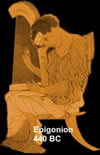 The epigonion is the harp-like instrument you’ve seen on a million Grecian vases. (Not the little lyre; the huge 40-stringed beast.)
The epigonion is the harp-like instrument you’ve seen on a million Grecian vases. (Not the little lyre; the huge 40-stringed beast.)
They stopped being made centuries ago, but we do have some fragments of medieval epigonions and some descriptions in the historical record.
Using those clues and computer modeling technology, researchers at the Ancient Instruments Sound/Timbre Reconstruction Application (ASTRA) have recreated the dulcet tones of the epigonion.
The physical modelling sound synthesis technique aims in fact to use a set of equations and algorithms that describe the physical materials used in the ancient instruments to generate physical source of sound. In other words, the basic idea is to recreate a model of the musical instrument and produce the sound by simulating its behaviour as a mechanical system.
For example, to model the sound of a drum, there would be a formula for how striking the drumhead injects energy into a two dimensional membrane. Thereafter the properties of the membrane (mass density, stiffness, etc.), its coupling with the resonance of the cylindrical body of the drum, and the conditions at its boundaries (a rigid termination to the drum’s body) would describe its movement over time and thus its generation of sound.
It actually sounds pretty damn good. I thought it would be more midi/computery sounding, but if I didn’t know it was virtually produced I wouldn’t have guessed.
For more music played on digitally-recreated historical instruments including Bach fugues complete with string profiles, see ASTRA’s download page.